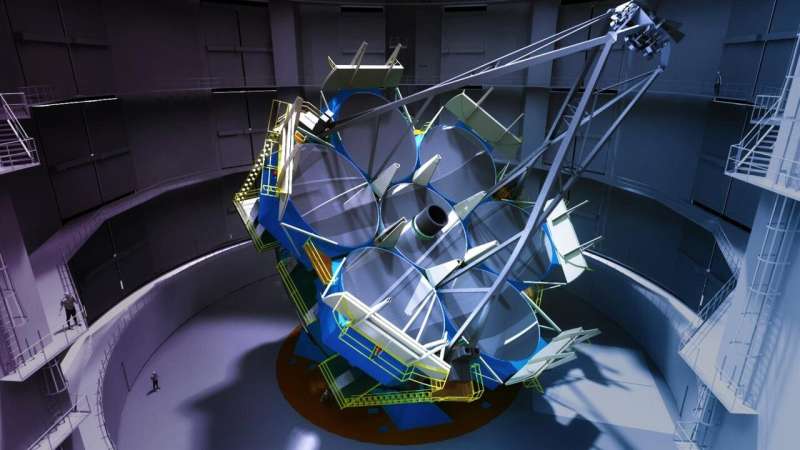"The most important part of a telescope is its light-collecting mirror," said James Fanson, Project Manager of the Giant Magellan Telescope. "The larger the mirror, the deeper we can see into the universe and the more detail we can observe. The Giant Magellan Telescope's unique primary mirror design consists of seven of the world's largest mirrors. Casting the sixth mirror is a major step toward completion. Once operational, the Giant Magellan Telescope will produce images ten times sharper than the Hubble Space Telescope. The discoveries these mirrors will make will transform our understanding of the universe."
The process of casting the giant mirror at Arizona's Richard F. Caris Mirror Lab involves melting nearly 20 tons (38,490 pounds) of high-purity, low-expansion, borosilicate glass (called E6 glass) into the world's only spinning furnace designed to cast giant mirrors for telescopes. At the peak of the melting process, the furnace spins at five revolutions per minute, heating the glass to 1,165 degrees Celsius (2,129 F) for approximately five hours until it liquefies into the mold. The peak temperature event is called "high fire" and will occur on March 6, 2021. The mirror then enters a one month annealing process where the glass is cooled while the furnace spins at a slower rate in order to remove internal stresses and toughen the glass. It takes another 1.5 months to cool to room temperature. This "spin cast" process gives the mirror surface its special parabolic shape. Once cooled, the mirror will be polished for two years before reaching an optical surface precision of less than one thousandth of the width of a human hair or five times smaller than a single coronavirus particle.
"I am tremendously proud of how the operations of the mirror lab have adapted to the pandemic, allowing our talented and dedicated members of the Richard F. Caris Mirror Lab to safely continue to produce the mirrors for the Giant Magellan Telescope," said Buell Jannuzi, Director of Steward Observatory and Head of the Department of Astronomy at the University of Arizona.
With the first two giant mirrors completed and in storage in Tucson, Arizona, the sixth mirror joins three others in various stages of production at the mirror lab. The third mirror's front surface polishing has achieved 70 nanometer accuracy and is less than one year from completion. The fourth mirror has completed rear surface polishing, and load spreaders are being attached to allow the mirror to be manipulated during operation. The fifth mirror was cast in November 2017, and the seventh mirror is expected to be cast in 2023. In addition, an eighth spare mirror is planned to be made that can be swapped in when another mirror requires maintenance.
In the late 2020s, the giant mirrors will be transported more than 8,100 kilometers (5,000 miles) to the Giant Magellan Telescope's future home in the Chilean Atacama Desert at Las Campanas Observatory more than 2,500 meters (8,200 feet) above sea level. The site is known for being one of the best astronomical sites on the planet, with its clear skies, low light pollution, and stable airflow producing exceptionally sharp images. Additionally, the site's southern hemisphere location gives the extremely large telescope access to the center of the Milky Way, which is of interest for many reasons, including the fact that it is the home to the nearest supermassive black hole, as well as many of the most interesting nearby galaxies. The southern hemisphere is also home to some of the most powerful observatories working at other wavelengths, making it the ideal location for synergistic scientific observations.
Once the Giant Magellan Telescope becomes fully operational, its seven mirror-array will have a total light collecting area of 368 square meters (3,961 square feet)—enough to see the torch engraved on a dime from nearly 160 kilometers (100 miles) away. Such viewing power is ten times greater than the famed Hubble Space Telescope and four times greater than the highly anticipated James Webb Space Telescope, expected to launch in late 2021. The mirrors are also a crucial part of the optical design that allows the Giant Magellan Telescope to have the widest field of view of any extremely large telescope (ELT) in the 30-meter class. The unique optical design will make the Giant Magellan Telescope the most optically efficient ELT when it comes to making use of every photon of light that the mirrors collect—only two reflections are required to direct light to the wide field instruments and only three reflections to provide light to the instruments that use small fields of view and the highest possible spatial resolutions.
"This unprecedented combination of light gathering power, efficiency, and image resolution will enable us to make new discoveries across all fields of astronomy, particularly fields that require the highest spatial and spectral resolutions, like the search for other Earths," said Rebecca Bernstein, Chief Scientist of the Giant Magellan Telescope. "We will have unique capabilities for studying planets at high resolution, which is the key to understanding if a planet has a rocky composition like our Earth, if it contains liquid water, and if its atmosphere contains the right combination of molecules to signal the presence of life."
Explore further



